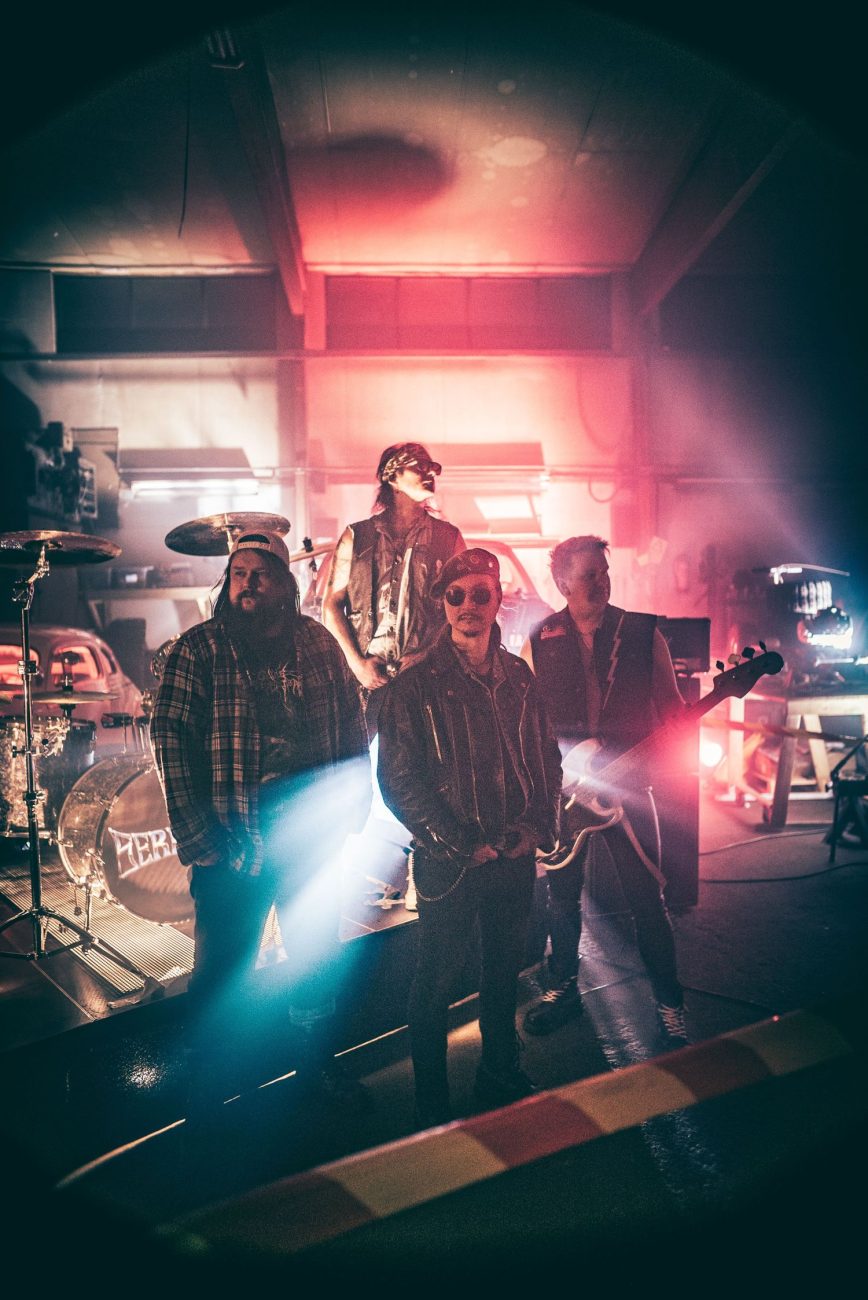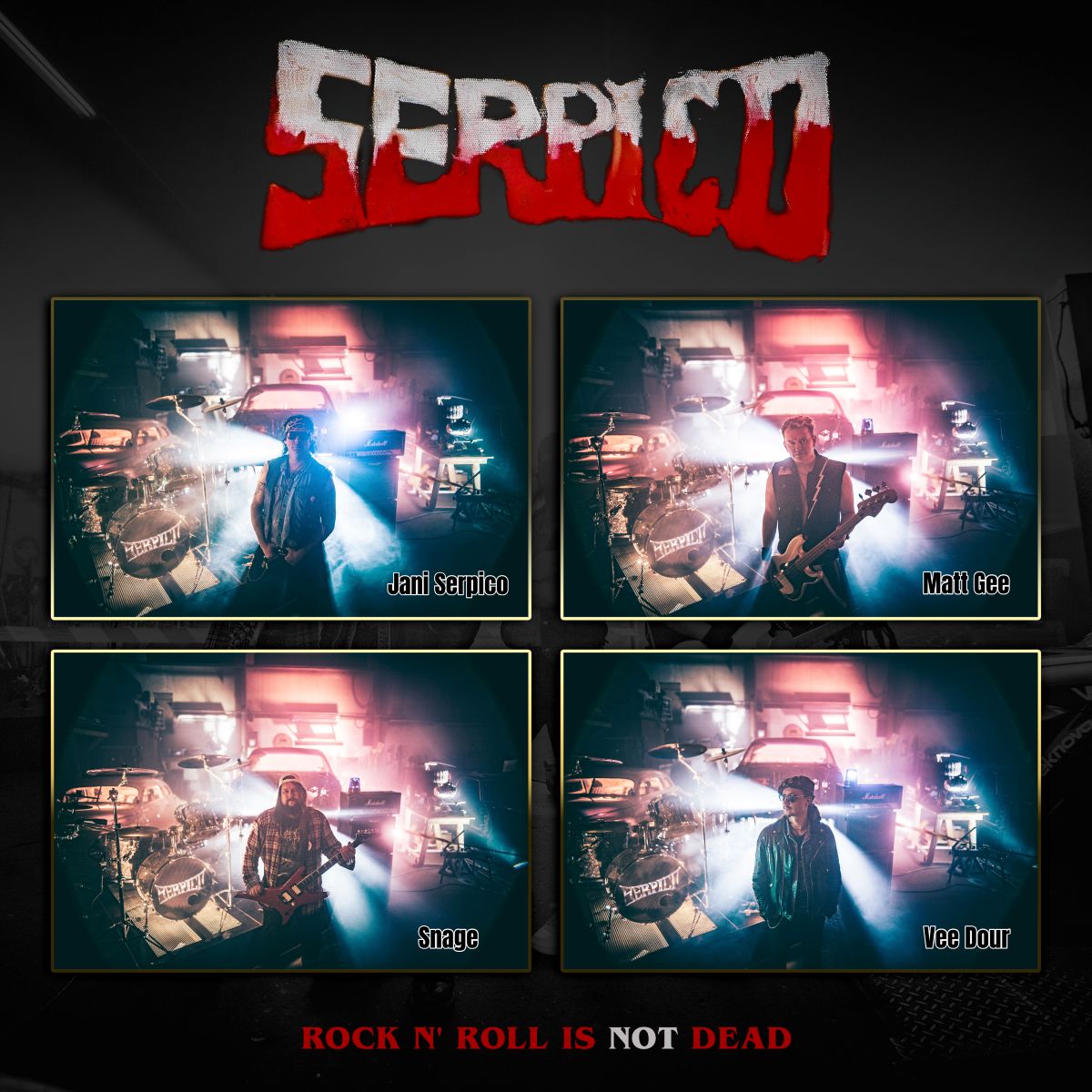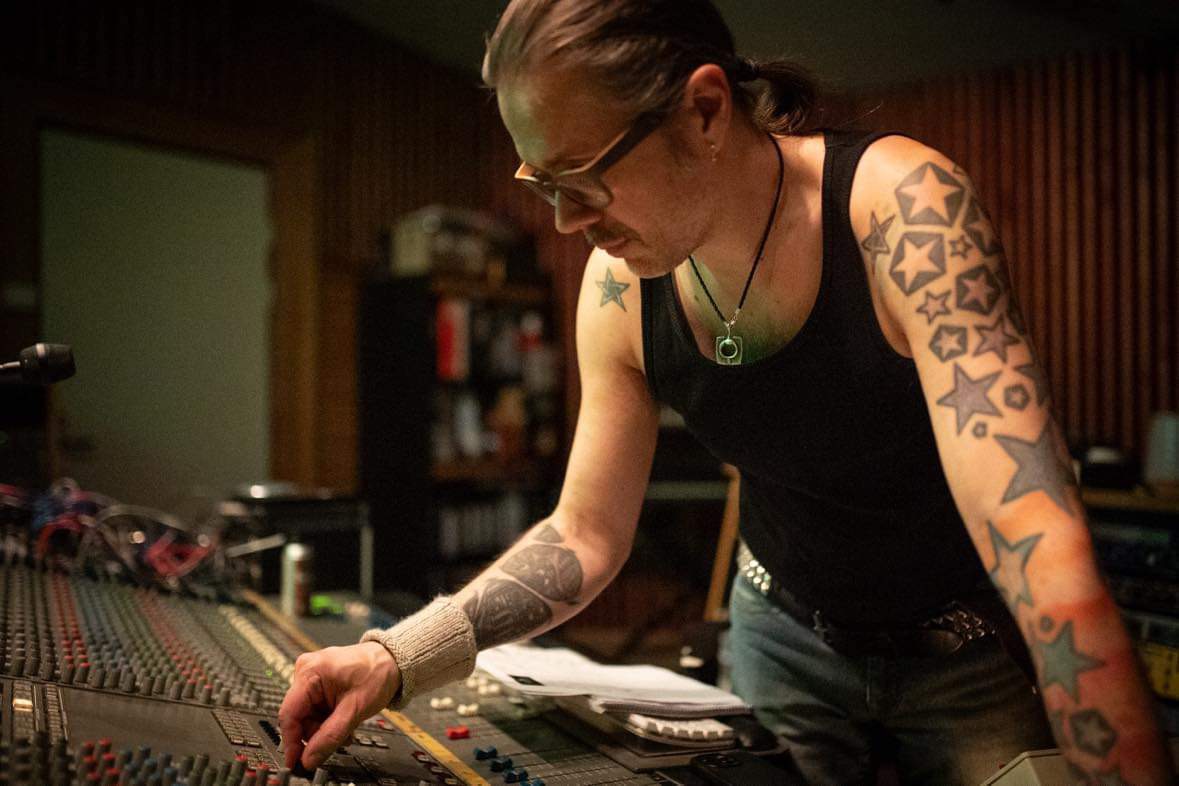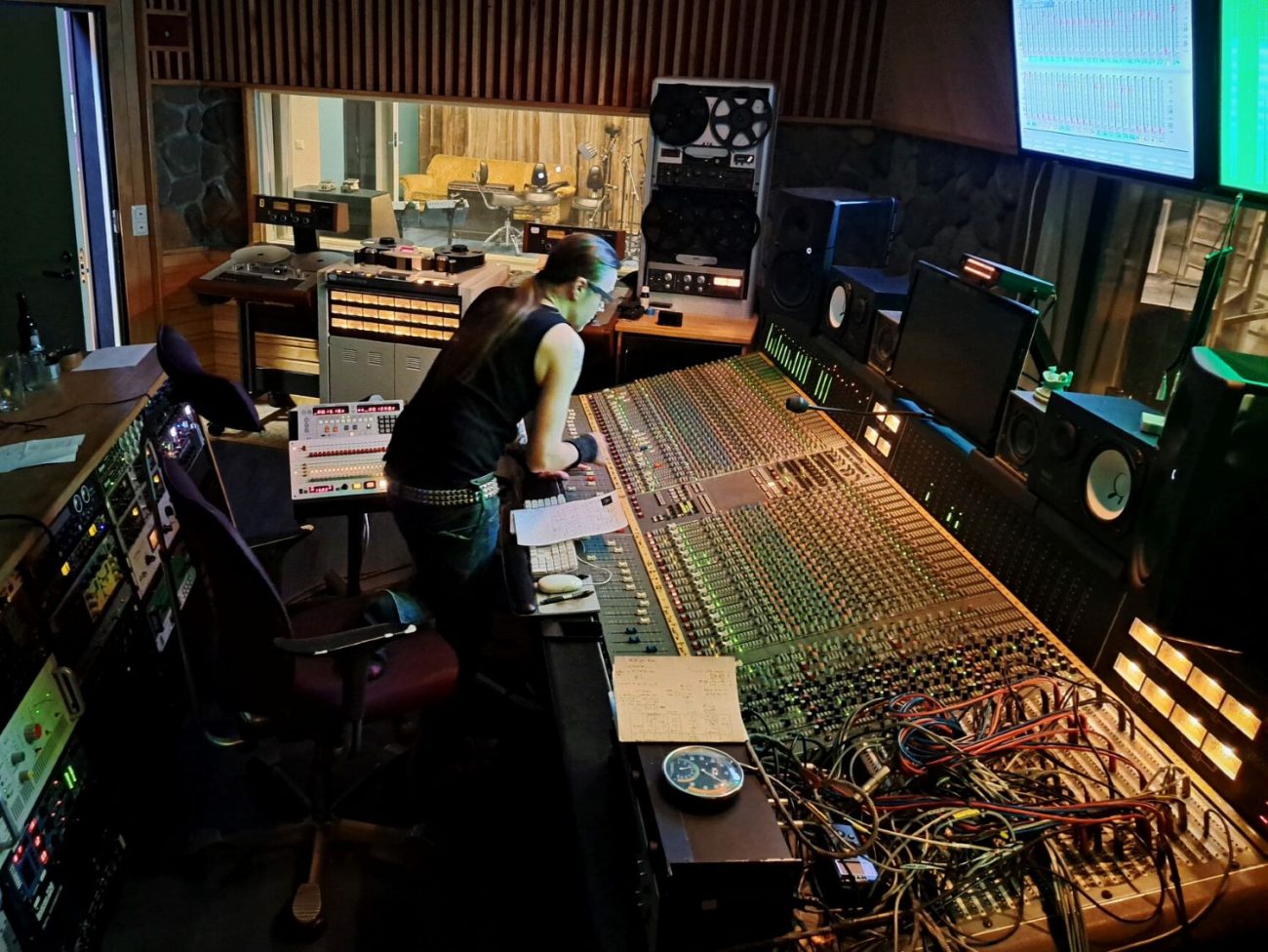“The new album will be much tighter than the last one” – Interview with Serpico and producer Anssi Kippo
Originating from Pori, Finland, the hard rock band Serpico was founded in 2005. A lot has happened over the years: they’ve released multiple albums, opened for acts like Michael Monroe and The 69 Eyes in Finland, made a whirlwind trip to London to support Geoff Tate, and completed eventful tours abroad with Rust N’ Rage, Bloody Heels and Princess. Now Serpico is turning a new page as the band signs a record deal with Golden Robot Records. Things are heating up for the fall release of “Dressed in Flesh”, out on September 12. The band has already dropped two hard-hitting singles “Hard as a Cannonball” and “Rock n’ Roll is Not Dead” – with the next one, “Sweet Rebel Darling”, crashing in on August 15.
Last fall, Chaoszine was invited to drop by Astia-studio to witness the recording sessions for the new album. We took the opportunity to catch up with the band about everything that’s been going on and what lies ahead. All members of Serpico, as well as the album’s producer and founder of Astia-studio, Anssi Kippo, sat down to chat with us. Check out the full interview, and of course, watch the brand-new studio documentary below!
Hello boys! It’s been a while since we last caught up, and a lot has happened since then. For example: you played a one-off show in London as the opening act for Geoff Tate’s Operation: Mindcrime. How was that experience?
Vee Dour: After soundcheck, when they rolled out a barricade in front of the stage, it hit me that this was something major. The venue was packed, 600 people on a Sunday night! The view from the stage was amazing: we could see every face in the crowd, their smiles, their expressions and so on. Even though it was just a 30-minute set, I’m so glad we did it. We also got to do some networking: there were music journalists in the crowd who came up to us afterwards with really positive feedback.
Matt Gee: Playing in London was a whole new experience compared to club gigs in Finland. When we kicked off the set, it took a couple of songs before it hit me how many people were out there. I just wish we’d had a longer set! Still, it was an incredible experience, and hopefully just the first of many like it.
Jani: It was amazing to play to a full house! When the audience started clapping and cheering, I honestly felt a bit overwhelmed in a good way. Some people even knew our songs already and were singing along, which was really wild.
Snage: Yeah, doing a one-off gig like that does come with its own expenses, of course, but we left with a great feeling. Hopefully a few people in the crowd remembered the name Serpico by the end of the night.
You’ve also signed with a new label: Golden Robot Records showed interest in the band?
Jani: Yeah, our management was actively looking for a label, and we decided to reach out ourselves as well. We contacted Golden Robot Records and sent them some tracks, and they really liked what they heard. Golden Robot owns several labels around the world, so that gives our music a solid distribution network. We’ll be hitting the road once the new album drops – hopefully with some international dates too! And overall, our team is looking strong: Jasmin Anglén from Stupido Booking is handling live bookings, and press and communications is in the hands of Ginger Vine Management & PR, led by Heta Hyttinen. Alongside the label, Rock’N’Growl Promotion (Alice Cooper, Ghost, Marilyn Manson, Sabaton) is handling media in Europe and the UK, while Metal Devastation PR (Napalm Death) is taking care of things in the US.
Vee Dour: Even though I’m not exactly a huge fan of social media, it actually played a role in connecting us with the label. Golden Robot had been following what Serpico was doing online and liked the vibe they saw.
Matt Gee: We’re excited – and a little anxious – in a good way. It’ll be interesting to see where things go from here over the coming year.
Snage: We don’t make music just for ourselves: we make it for the listeners. So I’m feeling optimistic about the new label and how things will unfold moving forward.
What can you tell us about the upcoming album “Dressed in Flesh”? Has anything changed since the last one?
Vee Dour: Now that we’ve done several sessions with Anssi Kippo, we’ve really gotten used to his methods. He’s all about making the studio recordings sound like a live performance – authenticity is key for him. The tracks that made it onto the album were chosen very carefully. I’ve usually handled most of the songwriting and lyrics, but this time our guitarist Snage has stepped up and taken more responsibility. So writing duties were mostly shared between the two of us, but of course the final versions were fine-tuned together with the whole band during rehearsals.
Matt Gee: I didn’t actually play on the last album, since I joined the band in fall 2021. But I was already very familiar with Serpico: I knew Jani and Vee Dour from before. From my perspective, this new record is going to be a bit heavier. Some of the tracks even have some Black Sabbath vibe!
Jani: The new album will be much tighter than the last one. We worked closely with Anssi to decide which songs made the cut.

Snage: Personally, I feel like I’ve grown as a guitar player since the last sessions. Playing feels smoother and more natural now. I can’t exactly pinpoint why: maybe we’ve been more focused in rehearsals, putting attention on the right details and leaving out the unnecessary stuff. Anssi has been a great guide in that process, helping us learn how to do things better overall.
Was Anssi Kippo and Astia-studio the obvious choice for this album too, or did you consider other options?
Vee Dour: After working here once, there really was no question! We were coming back.
Matt Gee: It goes both ways: Anssi is genuinely interested in Serpico, and we really vibe with his style and the opportunity to work in an all-analog environment. He’s fully invested in the project, almost like an extra band member. He gives great advice and suggestions that often push us out of our comfort zones in a good way and he is couraging us to try things we wouldn’t have thought of on our own.
Jani: I’ll repeat what I said earlier to Kaaoszine: when we were looking for a producer for our previous album, Anssi was the only one who actually responded. He showed real interest in us, and it’s easy to keep working with someone like that. What makes it even smoother is that we’ve become genuine friends, not just collaborators.
Snage: It was a no-brainer – we knew we’d come back here. Sure, it’s quite a trip from Pori, but there’s simply no other studio like this one.
Are all the songs on the new album completely new material, or did some ideas carry over from earlier sessions?
Vee Dour: Some of the tracks are based on slightly older ideas, but we’ve also got a few dark horses in the mix. Songs that were written right at the last minute before these sessions. One example is “Magma Hound”, which just kind of fell into place naturally.
Snage: I don’t think anything from the last album sessions ended up on this one. We created a lot of material for both records, but as far as I can remember, we haven’t really gone back to any of the old demos or leftovers.
How many recording sessions have you had here in Lappeenranta for this album?
Vee Dour: We’ve done three sessions in total, each focused on three songs. There were a few background elements left unfinished from the last session, and we’re wrapping those up now. We’re right on schedule, and everything’s gone according to plan.
Snage: Yeah, it’s been three songs per session – so if you do the math, that means the album will have nine tracks in total!
What does a typical studio day look like from the band’s perspective? Is there a set routine?
Vee Dour: We usually start around 10 AM and wrap up by 8 PM, so that’s a full workday. It’s important to stick to routines like home: we kick things off with breakfast and then dive straight into work. The days are packed with intense focus and there’s no slacking off.
Matt Gee: During breakfast, we often bounce ideas back and forth with Anssi. Studio days involve hard work: sometimes a take comes together quickly, and other times it takes longer to get it right. We’re on schedule so far, and no surprises have thrown us off yet.
Jani: No two days are exactly the same in terms of what we’re doing during the work hours because it varies. Studio days are intense, and we work as long as necessary. We aim to finish by 8 PM, but if needed, we’ll stretch it a bit longer.
Snage: The daily schedule stays pretty consistent, but what happens inside the studio varies. When we arrived here in Lappeenranta on Wednesday evening, we set up our gear and did a soundcheck. That way, everything was ready to go first thing in the morning. We record drums and bass first, then guitars and vocals follow in order. Everything moves at its own pace – Anssi is strict and keeps a good handle on things.
Regarding the visual side, you collaborated with Ville Juurikkala on the last album. Will he be involved again this time?
Vee Dour: Yes! We’re heading out to shoot the music video for the first single, “Hard as a Cannonball” with Ville. We’ll also be doing new promo photos at the same time. Ville is an amazing guy, and it’s great to be working with him again!
Jani: Ville was instantly on board to work with us again. He’s a really nice person and also a creative force of nature. He always comes up with spontaneous ideas that just work perfectly – we don’t follow any pre-written script with him.
Do you have any mottos?
Vee Dour: Well, at least we’ve tried!
Matt Gee: I’m gonna borrow one from a friend who once said: “If it isn’t a hell yes, then it’s a hell no.” Things really have to resonate with you.
Jani: I think this won’t surprise anyone: Rock ’n’ roll is not dead!
Snage: I’ve never really thought about having a motto, and I don’t think I’m going to come up with one off the cuff right now!
What message would you like to send to Chaoszine’s readers?
Vee Dour: Enjoy the music and really focus on it! Don’t scroll through social media at the same time – pay attention to what the artists have created with their art.
Matt Gee: Buy the album when it’s out and go to gigs, not just Serpico’s but other bands’ too. Music is a wonderful thing.
Jani: Take care of yourselves and stay healthy! Listen to the new album when it’s released!
Snage: Buy the album and come to our shows.

The legendary Astia-studio, located in Lappeenranta, Finland, was founded by Anssi Kippo in 1994. The studio is known for its fully analog, old-school approach to recording, with a focus on capturing the perfect sound organically. Over the years, it has been the birthplace of many memorable and historically significant recordings. Let’s hear more from Anssi himself about the studio’s history and his work with Serpico:
Hi Anssi, and welcome to the Chaoszine’s interview! To start off, can you tell us where we are right now?
Anssi: We’re currently at Astia-studio here in Lappeenranta. The studio was officially founded in 1994, although things actually got started a year earlier. But we go by the founding year: so as of now, Astia-studio is 30 years old. This is the third location the studio has operated in, and hopefully the final one.
Where did you originally get the idea to start a studio?
Anssi: I was playing in a band, and we wanted to record some music. But at the time, there wasn’t really a place here in Lappeenranta where that was possible, so we had to take matters into our own hands. We scrounged up a tape recorder from one place, found a suitable space through Yle, and so on. All in all, setting up a basic recording setup was a pretty laborious process.
Later on, I managed to get my hands on an 8-track analog tape machine and a small mixing console. When local bands found out that we had recording equipment at our rehearsal space, the requests to record started pouring in! Pretty soon, I didn’t have time for my own music anymore, and it was clear I needed to start a proper business. That’s how this whole thing started to escalate.
Where does the studio’s name come from?
Anssi: As those who speak Finnish may have noticed, it’s a playful nod to my last name! The name originally came from a band called Psycho Ward, which featured a certain singer-guitarist named Miitri Aaltonen. They were the first band I ever recorded – back when the studio was located in a church bomb shelter. When I saw the liner notes on their demo, there was: “Recorded in Astia-studios on September.” I figured, if it’s already printed on a demo cover, then there’s no turning back! You only see names like this in Donald Duck comics.
The name may have caused some credibility issues at first. Back in 1994, I called a company in Helsinki that sold studio gear and introduced myself as Anssi Kippo from Astia-studio. The first thing they asked was, “Is this a joke?” It took a few minutes to convince them I was serious. Eventually, they asked for an address to send brochures to. At the time, I was living with my mom near the university in Lappeenranta, at a street called Linnunrata 1 (which literally means Milky Way 1). When I said that on the phone, they hung up. The brochures never arrived either!

Do you remember what went through your mind when Serpico first reached out to you?
Anssi: I checked out their music and thought, “These are solid rock songs,” but I also felt that the sense of danger and tightness in the playing could be taken up a notch. I emphasized that analog tape recording would suit them really well.
Now you’re working on a second album with Serpico: how does the vibe feel this time around? From your perspective, has anything changed since the last session?
Anssi: Probably not much since their last visit, but compared to the very first session, the change is huge. A good example is the Case Study article about Serpico on the Astia-studio blog. I’m constantly helping them grow as musicians, and we’re aiming for an even more energetic result than before. Of course, in “Anssi’s music school,” the bar gets higher as the players improve!
While observing the sessions yesterday and today, I got the feeling that you’re almost like a member of the band yourself. Would you agree?
Anssi: Yes, I think that’s fair to say. The role of a producer can be a bit fluid depending on the situation. I approach every session with the same passion as if it were my own music. That said, I don’t try to make bands sound like me: I aim to highlight their own strengths and the unique character of their music.
The more we work together, the more shared history we build, and that becomes a foundation we can draw from. I often say that songs are like children – you can’t force them into a mold. You have to discover and support their individual strengths.
Would you say that your work requires a fair amount of psychological insight and people skills?
Anssi: Absolutely. I’d say maybe three percent of the job is actually operating and mastering the gear. And even that small part – especially learning to use analog signal path – takes years to truly understand. The rest is psychology. If you’ve got a musician in the studio who’s uninspired or emotionally beaten down to the point where nothing comes out, then even the best sound quality won’t help. What really matters is capturing the feeling. Every single note has to be played like it’s the last one you’ll ever get to play in your life.
From your perspective, what does a typical studio day look like?
Anssi: In a way, it’s like the movie “Groundhog Day”: breakfast at 9, followed by listening to some music on tape or vinyl, and then we start working at 10. At some point in the afternoon, we take a lunch break and continue until about 8 PM. In that sense, the days follow a routine, but you never know what kind of amazing things might happen within these studio walls.
We share a common goal, but there are many different paths to get there. Every day is different, because it all comes down to chemistry – how to create the right kind of tension that brings the music to life. For example, when a vocalist steps into the booth, how do we make them feel so comfortable from the very beginning that all possible distractions fade away? That’s what it’s all about.
You’ve been in the game a long time. How do you feel the music world has changed over the years and decades? Or has it…?
Anssi: It has changed dramatically. Back in the ’90s, there were fewer musicians, because audiences didn’t go to shows or buy records unless the artist had real talent. Nowadays, a lack of skill doesn’t stop anyone from becoming a singer or musician. Thanks to technology, anyone can sound apparently good – and it’s not always easy to tell who truly is. This has led to a kind of inflation in band culture, with so much supply out there.
Album sales have collapsed, but I believe we’ll see a shift: because progress often moves in cycles. Music no longer triggers the same emotional response it once did; it’s become more “content” than touching art.
What do you think about this: releasing singles one by one or a full album?
Anssi: Both have their merits. As an old-school music consumer myself, I rarely listen to just individual songs, because I mostly listen to music on vinyl or cassette tapes. I like putting on a whole album and focusing on it as it was meant to be heard. Of course, I also listen to tracks as background music sometimes, but that’s less common. A full album has a certain dramatic arc that takes us from one mood to another.

How do you see the future of music in general?
Anssi: I see the future as very bright. With the resurgence of vinyl, I also believe cassette tapes will make a comeback. They offer a way to restore revenue streams that have largely been missing from the music business over the past 15 years. When music is listened to solely via streaming services, bands don’t really benefit from it. This forces artists to compromise on quality, and nobody wins in that situation.
I also want to highlight the sound quality of the analog signal path, which has been shown to have positive health effects. You can explore this topic further, for example, through videos available on the Astia-studio website, by reading the article in the 8/2024 issue of Suomen Kuvalehti, or by watching our interview at the TerveysSummit (all in Finnish).
How do you see Serpico’s potential?
Anssi: I feel their potential is enormous! I hope that Golden Robot Records is ready to invest in them and provide the opportunities they truly deserve. Serpico has an amazing energy, and in my opinion, their songs are really impactful. Yesterday, when we started these sessions, I got chills just from the drum and bass tracks – and that’s always a good sign. That doesn’t happen with every band or every song.
What is your motto?
Anssi: Let’s do our best and give our all, every day and in everything we do.
What kind of greetings do you have for the readers of Chaoszine?
Anssi: I warmly recommend listening to analog signal path releases on vinyl records or cassettes, not through a digital amplifier. Enjoy what you hear – I can promise it moves you deeply!
There’s also a brand new studio documentary about the making of “Dressed in Flesh”. Check it out here:
Serpico is:
Vee Dour – vocals
Snage – guitars
Matt Gee – bass
Jani Serpico – drums
Learn more about the band via Linktree.
Want to see more of what Astia-studio is all about? Check it out here.